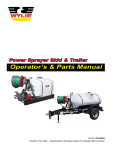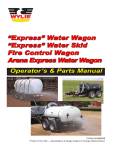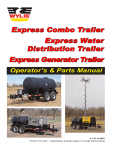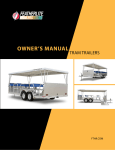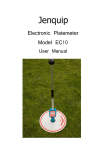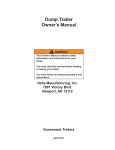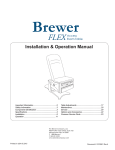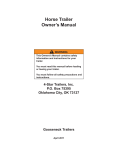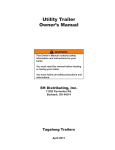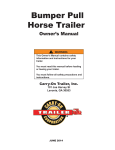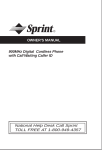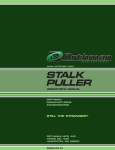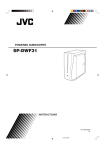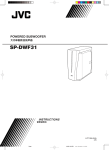Download Owner`s Manual PDF 1.80 MB
Transcript
DOT Trailers Operator’s & Parts Manual 3-1-13 05-18R6 Printed In The USA — Specifications & Design Subject To Change Without Notice! Warranty Information This equipment was carefully designed and manufactured to give you dependable service. To insure efficient operation of this equipment, please read this operator’s manual carefully. Check each item and acquaint yourself with the adjustments required to maintain optimum performance and operation. Remember, this equipment’s performance depends on how you operate and care for it! At the end of each season, thoroughly clean and inspect your equipment. Preventive maintenance saves time and pays dividends. Your nearest Wylie Spray Center has original equipment parts which assure proper fit and best performance. Record your equipment’s model and serial numbers and the date you purchased this equipment in the space below. Have this information available when you order parts or attachments. Model Number: Serial Number: Date Purchased: Limited Warranty This is a limited warranty. It covers products manufactured by WYLIE Mfg. Co. The Warrantor is WYLIE Mfg. Co., 702 E. 40th St., Lubbock, TX 79404 USA. The duration of the warranty for WYLIE manufactured equipment and products (excluding polyethylene tanks) is for one year from date of delivery to the carrier. The Warrantor warrants to the Buyer that the product(s) sold hereunder are free from defects to material and workmanship, under normal use and service, in the hands of the original buyer. If goods are defective, the defective goods will be replaced with identical goods. If identical goods are not available, the Buyer may elect to receive a refund of the purchase price for the defective goods, or the Buyer may order similar goods. The damage for defective goods shall not exceed the purchase price of the defective goods. No allowance shall be made for labor or expense or repairing goods without prior approval in writing by the Warrantor. The Buyer’s remedy under this warranty does not include incidental or consequential damages. For products not manufactured by the Warrantor, the Warrantor warrants these products to the extent of the warranties of their respective manufactures. There are no warranties which extend beyond this limited warranty, including the implied warranty of merchantability. Dealers or representatives shall not make any representation in regard to particular goods except as authorized by the Warrantor through a written warranty accompanying those particular goods. Disclaimer of Warranty WYLIE Mfg. Co., and its divisions, “Wylie Spray Centers,” in each location, requires as a condition of sale and coverage by its LIMITED WARRANTY that all equipment sold by it be used in accordance with the instructions and specifications of the Warrantor. This requirement is in addition to the LIMITED WARRANTY. Polyethylene and fiberglass tanks – These tanks are warranted for the storage and transport of water, herbicide solutions (on farm), liquid fertilizer and liquid feed. Such tanks should not be used for the storage of any bulk herbicide (undiluted). Any such use will render this warranty void. In addition, the Warrantor makes no warranty with regard to bulkhead tank fittings used in connection with tanks containing bulk herbicides and the use of any such fittings sold by the Warrantor or any WYLIE dealer in connection with tanks containing bulk herbicides is improper. Chemical Incompatibility – The Warrantor does not make any recommendations or warranties regarding chemical compatibility. WYLIE shall not be liable for any damages due to chemical incompatibility, and any Buyer or user should rely solely on written information furnished by the chemical manufacturer regarding chemical compatibility. No employee of WYLIE Mfg. Co., or its representatives, agents or dealers, is authorized to vary the terms of this limited warranty. Owner Registration Wylie Manufacturing Company 702 E. 40th St. Lubbock, TX 79404 Ph. 888-788-7753 DOT Trailer Date of Purchase Type of Trailer: Model Number Tank Serial Number Gooseneck Trailer Serial Number Tag Pump Model Wylie Invoice Number Owner’s Name Address CityStateZip Phone Email Dealer Owner’s Signature Must be returned within 10 days to validate the warranty. -- Or Register Online -Go to: www.wyliesprayers.com Platform . Table of Contents Table Of Contents Safety Issues............................................................................................................................................................2 - 3 Reporting Safety Defects.............................................................................................................................................. 3 Safety Decals & Placement........................................................................................................................................ 4-6 Introduction.................................................................................................................................................................... 7 Inspection & Setup...................................................................................................................................................8 - 9 Operation - Transport Trailers.............................................................................................................................. 10 - 11 Operation - Double Cone Trailers......................................................................................................................... 11 - 15 Operation - All Trailers..........................................................................................................................................16 - 17 Maintenance & Lubrication................................................................................................................................... 17 - 18 Troubleshooting Guidelines.................................................................................................................................. 19 - 20 Tire Safety Information.........................................................................................................................................21 - 31 Repair Parts.........................................................................................................................................................33 - 54 Gooseneck Trailer.......................................................................................................................... 34 Platform Trailer............................................................................................................................... 35 Leg Tank Tag Trailer...................................................................................................................... 36 Elliptical Tank Tag Trailer................................................................................................................ 37 1600 Gooseneck Tandem Axle Trailer............................................................................................ 38 1600 Tag & Platform Tandem Axle Trailer...................................................................................... 39 Pump and Plumbing, Tag Trailer.................................................................................................... 40 Pump and Plumbing, Gooseneck Trailer........................................................................................ 41 Lights & Breakaway Brake System................................................................................................ 42 Electrical Schematic....................................................................................................................... 43 Mix N’Fill......................................................................................................................................... 44 Sight Gauge................................................................................................................................... 45 Axles & Hubs...........................................................................................................................46 - 48 Double Cone Trailer....................................................................................................................... 49 Double Cone Pump Kits................................................................................................................. 50 Double Cone Plumbing...........................................................................................................51 - 52 Double Cone Axle/Hydraulics......................................................................................................... 53 Double Cone Hub Assembly.......................................................................................................... 54 1 Safety Issues Safety Precautions Be alert when you see the above symbol in the manual. It warns of a hazard which might lead to injury. It means: Attention! Become alert! Your safety is Involved! Three (3) words (Danger, Warning, and Caution) are associated with this symbol. DANGER – Indicates a hazardous situation, which, if not avoided, will result in death or serious injury. This signal word is to be limited to the most extreme situations. WARNING – Indicates a hazardous situation, which, if not avoided, could result in death or serious injury. CAUTION – Indicates a hazardous situation, which, if not avoided, may result in minor or moderate injury. NOTICE – Indicates information considered important, but not hazard-related (e.g., messages relating to property damage). SAFETY INSTRUCTIONS - Indicates a type of safety sign where specific safety-related instructions or procedures are described. Before Use Do not operate trailer until this manual has been read and understood! • Thoroughly read and understand all instructions before operating this trailer. If you have questions, please contact Wylie Manufacturing, 702 E. 40th St., Lubbock, TX 79404, (888) 788-7753. You can also contact your nearest Wylie Spray Center. • Make sure that the trailer is properly attached to the tow vehicle, including lights, safety chains, hitch and • • • • Check lug bolts for tightness and tires for wear. breakaway brake cable. Adjust hitch height as needed to assure that trailer is level when fully loaded. Always wear safety goggles, chemical resistant apron and rubber gloves when handling chemicals. Read and understand the chemical manufacturer’s safety guidelines on handling, mixing and application. During Use • • • Do not allow anyone to ride on trailer during operation. Falling can cause injury or death. Reduce speed when crossing uneven or rough terrain. Always turn off tow vehicle engine before making adjustments or repairs to an attached trailer. 2 Safety Issues After Use • • • • Inspect trailer for wear or damage. Ensure that all fasteners and fittings are tight. Flush tank and pump with fresh water if chemicals are used. Dispose of flush water using appropriate means. Carry out maintenance and/or lubrication procedures as outlined in this manual. Always • • • • • Keep hands, feet and clothing away from moving parts. Wear protective clothing and gloves when working with chemicals. Assure that the hitch is attached to the proper size ball. Attach the safety chains and breakaway brake cable to the tow vehicle. Plug the lights into the tow vehicle. Operator’s Instructions • When possible, avoid operating the tow vehicle near ditches, embankments and holes. • Reduce speed when turning, crossing slopes and on rough, slick or muddy surfaces. • Do not permit others to ride. • Operate tow vehicle smoothly – no jerky turns, starts and stops. • Hitch only to the hitch points recommended by the tow vehicle manufacturer. • When tow vehicle is idle, engage brakes and park lock securely. • Tighten lug bolts before transporting the first time and maintain proper torque. • Check lights and wiring daily. Service and replace to maintain proper operation. • Do not store or transport any petroleum based or flammable liquid in the polyethylene tank. Wylie Manufacturing, 702 E. 40th St., Lubbock, TX 79404 Reporting Safety Defects If you believe that your vehicle has a defect which could cause a crash or could cause injury or death, you should immediately inform the National Highway Traffic Safety Administration (NHTSA) in addition to notifying Wylie Manufacturing. If NHTSA receives similar complaints, it may open an investigation, and if it finds that a safety defect exists in a group of vehicles, it may order a recall and remedy campaign. However, NHTSA cannot become involved in individual problems between you, your dealer, or Wylie Manufacturing. To contact NHTSA you may either call the Auto Safey Hotline toll-free at 1-888-327-4236 (TTY: 1-800-424-9153); go to http://www.safercar.gov; or write to: NHTSA U. S. Department of Transportation 12000 New Jersey SE Washington, DC 20590 You can also obtain other information about motor vehicle safety from the http://www.safercar.gov. 3 Safety Issues Safety Decals & Placement DOT Trailers Contact us at [email protected] or 888-788-7753 to order safety decal or manual replacements. White Reflective Tape Decal #TMP-W200-12 Red & White Reflective Tape Decal #TMP-3M-980-02 Decal #V9020 Decal #V9029 4 Safety Issues Safety Decals & Placement DOT Trailers Contact us at [email protected] or 888-788-7753 to order safety decal or manual replacements. White Reflective Tape Decal #TMP-W200-12 Red & White Reflective Tape Decal #TMP-3M-980-02 Decal #V9020 Decal #V9029 5 Safety Issues Safety Decals & Placement DOT Trailers Red & White Reflective Tape Decal #TMP-3M-980-02 Decal #V9051R1 (If equipped) Decal #V9029 Contact us at [email protected] or 888-788-7753 to order safety decal or manual replacements. 6 Introduction 1,600 Gal. Gooseneck Platform DOT Trailer Twin 3,000 Gal. Double Cone DOT Trailer 1,600 Gal. Platform Tag DOT Trailer Introduction The Wylie DOT Trailers are the result of years of testing and field proven experience. They are built of the finest materials and expert workmanship to provide you with years of reliable service. The DOT Trailers are available with a 300 to 1,600 gallon tanks and a choice of frame styles -- gooseneck or tag. Also available is a double cone DOT trailer with twin 3,000 gallon cone tanks. Other available features include a transfer pump powered by a Honda or Briggs & Stratton engine, quick fill and sparger, and a sight gauge for black tanks. The DOT Trailers come standard with lights, electric brakes, breakaway brake kit and heavy duty walkway fenders. The Wylie DOT Trailers are designed to transport potable water, fertilizer, dilute herbicides and insecticides, and many other non-petroleum based chemicals. This manual explains how to safely and properly operate and maintain your DOT Trailer. Thoroughly read and understand the contents of this manual before operating your trailer. If you have questions or do not understand particular items, contact your nearest Wylie Spray Center or call Wylie Manufacturing at (888) 788-7753. Please keep this manual handy to answer questions you may have as they arise. Pay Particular Attention To All Safety Suggestions – Their purpose is to assure safe operation of the sprayer and prevent injury or damage to yourself or the unit. 7 Inspection & Setup Inspection & Setup Your DOT Trailer is delivered ready for operation. However, it is suggested that you check lug nuts and other fasteners for proper torque. Check the motor, if equipped, to assure that it has the proper oil level (see the motor operator’s manual for details). Make a visual inspection to assure that nothing was damaged in shipping. Report any problems to your dealer or to Wylie Manufacturing. Light Plug > Attaching Gooseneck Trailer To Truck < Brake Cable 2 5/16” Ball > The ball and hitch must be the same size. Attaching a 2 5/16” hitch to a 2” ball could allow the trailer to become unhitched during transport. Serious bodily injury could follow. < Safety Chain Figure A3 Gooseneck Attachment To Truck The gooseneck trailer jack is a two-stage system. Turn the handle counterclockwise to raise the jack pad off of the ground. Pull the spring loaded lock pin out and raise the jack pad. Continue turning the handle to raise the jack to the highest position. All Wylie gooseneck trailers require a 2 5/16” ball mounted in the bed of the truck as well as a seven prong light plug. Align the truck with the gooseneck hitch and lower the hitch by turning the jack handle counterclockwise. Once the hitch is lowered over the ball, insert the lock pin and secure with the clip pin. Hook the safety chains into the truck eyelets. Jack Handle > <J ack Figure A1 Installing Gooseneck Lock Pin The Wylie DOT gooseneck trailer is equipped with a breakaway brake system that activates the trailer brakes if the trailer becomes separated from the truck. A breakaway brake cable must be attached to the truck. Loc kP in Figure A4 Gooseneck Trailer Jack Attaching Tag Trailer To Truck The ball and hitch must be the same size. Attaching a 2 5/16” hitch to a 2” ball could allow the trailer to become unhitched during transport. Serious bodily injury could follow. Figure A2 Test Button on Breakaway Brake System The breakaway brake system is equipped with a test button and lights to show the status of the breakaway system battery. Depress the test button to see the status. The Wylie 1,000-1,600 gallon DOT trailers require a 2 5/16” ball, while the 300 and 500 gallon trailers use a 2” ball. Make sure that the ball and hitch are the same size. 8 Inspection & Setup Raised > Frame lec <E Figure A5 e-Z Latch™ 2 5/16” Coupler e abl C tric lip <C Standard 2” Coupler Crossed > Safety Chains Some DOT trailers are equipped with the e-Z Latch™ 2 5/16” coupler which features a raised latch frame. The e-Z latch coupler will automatically lock itself on the ball as the trailer is lowered. Do not rotate the hitch handle to attach the trailer to the ball. Only rotate the hitch handle to detach the trailer from the ball. Pin Breakaway > Brake System < Breakaway Brake Cable Figure A7 Tag Trailer Attachment To Truck Plug the light cable into the truck light socket. Check the lights to make sure that the clearance, turn, brake and tail lights are working properly. < Trigger Pull the jack pin and rotate the jack or remove the jack from the mount collar. Hitch Handle > The Wylie DOT tag trailer is equipped with a height adjustable hitch. The trailer should travel level when the tank is full. To level the hitch, lower the jack to support the tongue, remove the hitch bolts, adjust the tongue height as needed, and reinsert the hitch bolts. Figure A6 Rotate Lock Tab To Open 2” Hitch Open the 2” hitch by depressing the trigger and rotating the hitch handle upward until the hitch locks open. Align the truck under the hitch and lower the hitch onto the ball by rotating the jack handle counterclockwise. Rotate the hitch handle until the trigger locks in place. Secure the hitch handle with a clip pin. Attach the safety chains to the eyelets. DOT regulations require that the safety chains cross as they are attached. Figure A8 Test Button on Breakaway Brake System The breakaway brake system is equipped with a test button and lights to show the status of the breakaway system battery. Depress the test button to see the status. Electric brake trailers have a battery powered breakaway brake system that activates the trailer brakes if the trailer becomes unhitched from the truck while travelling. Attach the brake cable to the hitch. 9 Operation Operation -- Transport Trailers The Wylie DOT Trailers can perform a wide variety of jobs. This manual will describe the basic operation of the trailer. The operator must use safe operating procedures and common sense as the trailer is used in a particular applications. Note: Open the ball valves by turning the handle parallel to the flow. Close the valve by turning the handle perpendicular to the flow. (2) The quick-fill fitting allows the tank to be filled while standing on the ground, which is safer than climbing onto the fender. If the fluid source is gravity fed, it may be faster to fill the tank using the transfer pump (if equipped). Remove the cap from the quick-fill fitting and quick couple the fill hose to the quick-fill fitting. Close the main tank valve, open the sparger valve (if equipped, if not, insert discharge hose into tank lid), and start the engine. Filling The Tank The tank can be filled by three means: (1) through the tank lid (2) through the quick-fill fitting using the trailer pump (3) through the quick-fill fitting without using the trailer pump. < Open Sparger Valve Closed Main Tank Valve > Open Fill Valve > Always wear protective clothing, i.e. apron, face shield, gloves and respirator, when handling any chemicals. Failure to do so will risk chemical exposure to your body resulting in sickness, injury or possibly death. Figure B2 Filling Tank Using Transfer Pump (1) To fill the tank through the tank lid, remove the tank lid, insert the fill hose into the tank and turn the fluid source on. Many times, the source has sufficient pressure that requires the fill hose be held in place to prevent the fill hose from coming out of the tank and spilling fluid. The heavy duty fenders are designed to be used as walkways and can be used to gain access to the tank lid. (3) If the fluid is supplied from a pressurized source, quick couple the fill hose to the quick fill fitting, open the main tank valve, and start the flow of fluid. Open Main Tank Valve > Open Fill Valve > Figure B3 Filling Tank From Pressurized Source Mixing The Solution Some solutions may require mixing before transferring them to a sprayer or other tank. Open the main tank valve and the sparger valve (if equipped). Start the engine and allow the fluid to thoroughly mix. Figure B1 Filling Tank Through Tank Lid Opening 10 Operation Operation -- Transport Trailers con’t. Controlling Surge Wylie polyethylene tanks have a partial baffle molded into the tank to help control surge or movement of the fluid during transport. If additional surge control is needed, Surge Buster™ inserts are available from Wylie Spray Centers. < Open Sparger Valve Open Main Tank Valve > Closed Fill Valve > Figure B4 Mixing Solution Discharging the Solution Open the main tank valve and close the sparger valve (if equipped). Unroll the discharge hose and close the discharge valve. Start the engine, place the discharge valve where needed, and open the discharge valve. Figure B7 “Surge Buster™” Liquid Tie Down System Open Valve > Surge Buster™ > Figure B5 Valve Setting for Discharging Fluid Figure B8 Inserting Surge Busters™ Into the Tank < Closed Valve Figure B6 Discharge Valve 11 Operation Operation -- Cone Bottom Trailers Cone Trailers * Push the transport locks “in” on both sides of the trailer to disengage the locks. Lowering the trailer with only one transport lock disengaged will cause equipment damage. Cone Trailers are designed to be transported empty. To lower trailer for loading: * Select a level location for the trailer. Placing the trailer on a hillside will result in uneven loads on the tank when full and can cause tank failure. * Unhook cone trailer from tow vehicle. Transport Lock > All people must be clear of the cone trailer frame when it is lowered to the ground. Failure to do so could cause bodily injury. * Rotate hydraulic pump valve handle clockwise until tight. Raise trailer off transport locks by stroking hydraulic pump handle. If the trailer will not raise high enough, there may be air in the system or the pump may need adjustment. See page 14-15 for instructions. Figure B11 Disengaging Transport Lock (Both Sides of Trailer) * Rotate the jack handle to allow the tongue to settle to the ground. < Pump Valve Handle Figure B9 Rotate Pump Valve Handle Clockwise to Raise Trailer Figure B12 Tongue Lowered to Ground * Rotate the hydraulic pump valve handle counterclockwise slowly and allow the frame to slowly settle to the ground. Figure B10 Raising Trailer Off Transport Locks Load fluid into the cone trailer tanks only when the frame is resting on the ground. Holding or transporting fluid when the trailer is supported by the tires can cause mechanical damage and failure. 12 Operation Operation -- Cone Bottom Trailers con’t. Filling through transport 3” coupler: The Cone Trailer is equipped with a 3” quick coupler at the rear of the trailer. If filling from a transport truck, connect the truck hose to the 3” coupler, open the 3” ball valve and open the tank valves for each of the tanks to be filled. < Figure B13 Rotate Valve Handle Counterclockwise to Lower Trailer nk n Ta Ope e Valv n 3” e < Op k Hose 3” Truc e Valv > Figure B16 Open 3” Valve and Tank Valves Fill the tanks to the desired level. Close the 3” valve, then close the tank valves. Figure B14 Lowered Cone Trailer Filling The Cone Trailer The Cone Trailer is designed with a versatile plumbing system that allows the Cone Trailer to be filled for different applications. The tanks can be filled with the same solution or valves can be set to store as many as three different solutions (depending on the number of cone tanks) in the Cone Trailer. Fron t Tan Main Valve > k Val ve > ear) > alve (R 3” Fill V Figure B15 Cone Trailer Valves 13 Operation Operation -- Cone Bottom Trailers con’t. Transporting Cone Trailer Unloading Cone Tanks The cone tanks can be unloaded with a pump on the receiving vehicle or by an optional pump mounted on the Cone Trailer. Do not raise or transport the Cone Trailer with any fluid in the cone tank. The trailer axles, hubs and tires are not rated to support the extra weight. Raising or transporting a partially loaded Cone Trailer can result in mechanical damage or failure. If the Cone Trailer is not equipped with a pump, couple a transfer hose (not included) to the quick coupler near the main valve. Open the main valve and appropriate tank valve. Start the pump. Before raising or moving the Cone Trailer, unload all fluid from the cone tanks. The Cone Trailer is designed to be raised and transported with empty tanks. If the Cone Trailer is equipped with a transfer pump, unroll the discharge hose from the hose rack and insert the discharge valve in the receiving tank. Keep the valve closed until the other valves are set. (The discharge valve can be equipped with a quick couple fitting for attachment to a corresponding fitting on the receiving vehicle.) Once the tanks are empty, rotate the hydraulic pump valve handle clockwise until closed as shown in Figure B9. Stroke the hydraulic pump handle to raise the frame to its highest position as shown in Figure B10. Slide the transport lock out on both sides of the trailer as shown in Figure B11. Rotate the hydraulic pump valve counterclockwise slowly to allow the transport locks to lower to the axles. Rotate the jack handle to raise the tongue to the towing height. < Open Discharge Valve Attach the tow vehicle to the Cone Trailer according to the directions on page 9. Adjusting Hydraulic Pump If the empty trailer will not raise enough for the transport locks to be engaged or disengaged, the hydraulic pump may need additional hydraulic fluid, it may need the bypass adjusted, or air may need to be bled from the lines. Figure B18 Discharge Valve Check the fluid level only when the trailer is in the lowered position. Remove the plug from the top of the hydraulic reservoir. Open the appropriate tank valves and the main valve. Start the engine, then open the discharge valve. ose arge H h < Disc Open < Op en M Tank Valve ain V alve > Figure B19 Valve Setting For Drawing From Tank 14 Figure B20 Hydraulic Fluid Fill Plug Operation Operation -- Cone Bottom Trailers con’t. Tire Changing System Selected DOT Cone Trailer models are equipped with a spare tire and a tire change valve which allows the tires to be raised off the ground to change a flat tire. Fill with fluid to the top of the reservoir. Replace the plug. Note: Filling the reservoir when the trailer is in the raised position will overfill the system and will cause an overflow when the trailer is lowered. To adjust the bypass, loosen the jam nut, rotate the set screw, then tighten the jam nut. Generally, the proper setting is for the set screw to be flush with the jam nut. If the trailer will not raise, rotate the set screw “in” one full turn. If the hydraulic handle will not stroke, rotate the set screw “out” one full turn. Lower the frame to the ground before rotating the Tire Change valve from the Normal to Tire Change position. Rotating to the Tire Change position with a raised frame can cause the frame to drop, resulting in serious bodily injury. Tire Change Valve > Figure B21 Adjusting Hydraulic Pump Bypass If air is in the system, it is necessary to “bleed” the air for the hydraulic system to work properly. Loosen the hose fitting slightly at the cylinder and allow the air to escape. When pure hydraulic fluid flows from the fitting, retighten the fitting. If necessary, stroke the pump to force fluid through the system. Figure B23 Tire Change Valve in Normal Position The valve should stay in the “normal” position for most operations. If a tire should go flat, lower the frame to the ground as described on page 14. Rotate the tire change valve to the “Tire Change” position. With the hydraulic pump valve closed, stroke the hydraulic pump to raise the tire for removal. Tire Change Valve > Hydraulic Pump > < Hydraulic Pump Valve Figure B22 Loosening Hydraulic Hose Fitting to Bleed Air From System Figure B24 Tire Change Valve on DOT Cone Trailer 15 Operation Operation -- All Trailers Trailer Operation Towing a loaded trailer requires added care and concentration for safe operation. DOT approved for non-flammable and non-hazardous materials only. Transporting flammable or hazardous materials in this trailer may be dangerous and unlawful. Storing or transporting petroleum based fluids can cause the tank to fail and will void the warranty. (1) Loaded trailers require a longer stopping distance. Maintain an increased following distance. (2) Trailers turn a shorter radius than the tow vehicle. Swing wide on turns to prevent colliding with other vehicles or structures. Black Tank and Sight Gauge DOT trailers that are intended to haul water may be equipped with a black tank and sight gauge. The opaque black tank prevents sunlight from forming algae in the tank. The sight gauge allows the operator to observe the fluid level in the tank. (3) Loaded trailers require more time to attain highway speeds. Take extra care when merging with traffic. (4) Make sure that the tow vehicle is sized to properly tow the trailer at maximum load. The hitch must also be rated to handle the maximum trailer load. (5) Make sure that the tow vehicle is properly equipped to safely tow the trailer. The tow vehicle should be equipped with functional light and brake equipment, safety chain anchors, and correctly sized and anchored ball. (6) Check the following components regularly: Tires: Check and maintain proper inflation daily. Lights: Inspect lights, wiring and plug daily. Replace damaged or worn components. Brake battery: Keep breakaway battery (electric brakes) charged. Replace if it will not hold a charge. Wheel bearings: Repack bearings every 6 months or 6,000 miles. Check hubs daily for heat buildup. Excess heat is a sign of insufficient lubrication and impending failure. Sight Gauge > Hitch: Before each trip, make sure that the hitch is properly locked on the ball. Replace the hitch if it becomes worn or inoperable. Chemical Compatibility Wylie polyethylene tanks are designed to hold a wide variety of fluids, but are not compatible with some fluids. Wylie polyethylene tanks are not designed to hold petroleum based chemicals or petroleum fuels. If you have any questions regarding the chemical compatibility with Wylie polyethylene tanks, call Wylie Customer Service at 888788-7753 or your nearest Wylie Spray Center. Sight Gauge Valve > Figure B25 Sight Gauge The sight gauge is equipped with a ball valve. The valve can be closed to prevent loss of fluid if the tube becomes damaged or to facilitate changing of the tube. 16 Maintenance & Lube Operation -- All Trailers Cargo Platform Some DOT trailer models are equipped with a cargo platform that is sized to carry a bulk chemical tote or fork lift pallet. The platform should be loaded from the left (driver’s) side. The load should be secured with ratchet straps anchored to the trailer frame. Load the platform only when attached to a tow vehicle. Figure B26 Cargo Platform Maintenance & Lubrication Freeze Protection The tank and fittings are susceptible to rupture in freezing conditions if water or some other fluids are left in the tank or plumbing. To prevent freeze damage, the tank and plumbing should be drained. Remove the plug beneath the tank, the pump drain plug, and open valves to allow the water to drain from the system. The system can be further protected by adding a few gallons of nontoxic RV antifreeze solution to the tank and pumping it through the plumbing system. Lubrication The wheel bearings should be packed every 6 months or every 6,000 miles (whichever comes first). Lubrication may be needed more often if the trailer is used in severe conditions. The wheel hubs should be checked regularly for excess heat. Heat buildup is an indication that the bearings need grease and may soon fail. The wet hubs of the 1600 Tandem Axle Nurse Trailers use SAE 90 Grade Gear Oil. To add oil, remove the rubber boot and add oil to the fill line. Nut Tightening Sequence > Tank Drain Plug > Rubber Boot > Figure C1 Tank Drain Plug Figure C2 1600 Tandem Axle Wheel Hub Pump/Motor Refer to the manuals provided by the pump and motor manufacturer for maintenance instructions for the respective components. If a wheel is removed, it is imperative that the lug nuts be tightened in sequence when the wheel is mounted. Note the decal for the nut tightening sequence. 17 Lubrication Recommended Lubrication Nurse Trailers Cone Trailers Wheel Hub Assemblies Repack every 6 months Folding Chains Oil every week Cone Trailer Axle, Cylinder Side (1 grease zert) Grease weekly Cone Trailer Axle, Pump Side (1 grease zert) Grease weekly 18 Troubleshooting Troubleshooting Guidelines - All Trailers Problem Cause Solution Electric trailer brakes not operating (1) Electric trailer plug not properly pugged into vehicle (2) Vehicle brake controller malfunctioning (3) Brake shoes improperly adjusted (4) Brake shoes worn (1) (2) (3) (4) Surge trailer brakes not operating (1) Hydraulic fluid level is low (2) Air in brake system (3) Hydraulic brake line damaged or broken (4) Brake shoes improperly adjusted (5) Brake shoes worn (1) Add brake fluid (fluid must be approved, clean, and uncontaminated) (2) Bleed brakes to remove air (3) Replace brake line (4) Adjust brake shoes (5) Replace brake shoes Brakes will not release (1) Emergency brake system is engaged (2) Brake controller is engaged (1) Electric brakes -- Plug emergency brake “key” into receptacle (1) Surge brakes -- Disengage emergency brake lever (2) Disengage brake controller One or more lights not working (1) Light bulb burned out (2) Loose or broken wire (1) Replace light bulb (2) Repair loose or broken wire Lighting system is not working (1) Electric trailer plug not properly pugged into vehicle (2) Blown fuse (3) Loose or broken wire (1) Properly connect to tow vehicle (2) Replace fuse (3) Repair loose or broken wire Pump Will Not Operate (1) Engine not starting or running properly (2) Coupler between pump and engine broken (1) Refer to engine owner’s manual (2) Replace coupler Pump will not move solution (1) (2) (3) (4) (5) (1) (2) (3) (4) Properly connect to tow vehicle Check and repair brake controller Adjust brake shoes Replace brake shoes Fill tank Open ball valve Clean strainer screen See pump owners manual or contact Wylie Spray Center (5) Open discharge valve Tank empty Main tank ball valve closed Plugged strainer Malfunctioning pump Discharge valve not open 19 Troubleshooting Troubleshooting Guidelines - All Trailers con’t. Problem Cause Solution Fill tank Open ball valve Clean strainer screen Replace suction hose Tighten fittings; Check for cracked or cut components; Apply thread sealant to pipe threads; Close fill valve. (6) See pump owners manual or contact Wylie Spray Center (7) Increase engine speed (8) Close sparger valve Pump output is very low; erratic (1) (2) (3) (4) (5) (6) (7) (8) Solution in Mix N’Fill tank is not drawn into system (1) Main tank valve is fully open (2) Mix N’Fill tank valve is closed (3) Discharge hose valve is closed (1) Partially close main tank valve to “starve” pump slightly (2) Open Mix N’Fill tank valve (3) Open discharge hose valve (1) Mix N’Fill valve is open allowing gravity feed fill (1) Close Mix N’Fill valve Mix N’Fill tank fills or overflows Spray tank low; air getting in pump Tank ball valve partially closed Plugged strainer Collapsed suction hose Air leak in suction system Malfunctioning pump Engine speed too slow Sparger (bypass) valve is open (1) (2) (3) (4) (5) Cone Trailer Troubleshooting Guidelines Problem Trailer will not raise Trailer will not lower Lift pump handle will not operate Cause (1) (2) (3) (4) Solution (1) Tighten lift pump valve handle (2) Screw lift pump bypass “in” one turn (3) Add fluid to top of reservoir when trailer is in lowered position (4) Empty tanks completely before raising trailer Lift pump valve handle is not tight Lift pump bypass not set properly Lift pump hyd. fluid level is low Tanks are not empty, overloading pump and cylinder (1) Transport locks are engaged (2) Transport lock is engaged on one side (1) Raise trailer off transport locks and slide transport locks “in” to disengage (2) Disengage transport locks on both sides of trailer (1) Lift pump bypass not set properly (1) Screw lift pump bypass “out” one turn 20 Tire Safety Information Tire Safety Information 1. TIRE SAFETY INFORMATION This portion of the User’s Manual contains tire safety information as required by 49 CFR 575.6. Section 2.1 contains “Steps for Determining Correct Load Limit - Trailer”. Section 2.2 contains “Steps for Determining Correct Load Limit – Tow Vehicle”. Section 2.3 contains a Glossary of Tire Terminology, including “cold inflation pressure”, “maximum inflation pressure”, “recommended inflation pressure”, and other non-technical terms. Section 2.4 contains information from the NHTSA brochure entitled “Tire Safety – Everything Rides On It”. This brochure This brochure, as well as the preceding subsections, describes the following items; Tire labeling, including a description and explanation of each marking on the tires, and information about the DOT Tire Identification Number (TIN). Recommended tire inflation pressure, including a description and explanation of: A. Cold inflation pressure. B. Vehicle Placard and location on the vehicle. C. Adverse safety consequences of under inflation (including tire failure). D. Measuring and adjusting air pressure for proper inflation. Tire Care, including maintenance and safety practices. Vehicle load limits, including a description and explanation of the following items: A. Locating and understanding the load limit information, total load capacity, and cargo capacity. B. Calculating total and cargo capacities with varying seating configurations including quantitative examples showing / illustrating how the vehicles cargo and luggage capacity decreases as combined number and size of occupants’ increases. This item is also discussed in Section 3. C. Determining compatibility of tire and vehicle load capabilities. D. Adverse safety consequences of overloading on handling and stopping on tires. 1.1. STEPS FOR DETERMINING CORRECT LOAD LIMIT – TRAILER Determining the load limits of a trailer includes more than understanding the load limits of the tires alone. On all trailers there is a Federal certification/VIN label that is located on the forward half of the left (road) side of the unit. This certification/VIN label will indicate the trailer’s Gross Vehicle Weight Rating (GVWR). This is the most weight the fully loaded trailer can weigh. It will also provide the Gross Axle Weight Rating (GAWR). This is the most a particular axle can weigh. If there are multiple axles, the GAWR of each axle will be provided. If your trailer has a GVWR of 10,000 pounds or less, there is a vehicle placard located in the same location as the certification label described above. This placard provides tire and loading information. In addition, this placard will show a statement regarding maximum cargo capacity. Cargo can be added to the trailer, up to the maximum weight specified on the placard. The combined weight of the cargo is provided as a single number. In any case, remember: the total weight of a fully loaded trailer can not exceed the stated GVWR. For trailers with living quarters installed, the weight of water and propane also need to be considered. The weight of fully filled propane containers is considered part of the weight of the trailer before it is loaded with cargo, and is not considered part of the disposable cargo load. Water however, is a disposable cargo weight and is treated as such. If there is a fresh water storage tank of 100 gallons, this tank when filled would weigh about 800 pounds. If more cargo is being transported, water can be off-loaded to keep the total amount of cargo added to the vehicle within the limits of the GVWR so as not to overload the vehicle. Understanding this flexibility will allow you, the owner, to make choices that fit your travel needs. When loading your cargo, be sure it is distributed evenly to prevent overloading front to back and side to side. Heavy items should be placed low and as close to the axle positions as reasonable. Too many items on one side may overload a tire. The best way to know the actual weight of the vehicle is to weigh it at a public scale. Talk to your dealer to discuss the weighing methods needed to capture the various weights related to the trailer. This would include the weight empty or unloaded, weights per axle, wheel, hitch or king-pin, and total weight. 21 Tire Safety Information Excessive loads and/or underinflation cause tire overloading and, as a result, abnormal tire flexing occurs. This situation can generate an excessive amount of heat within the tire. Excessive heat may lead to tire failure. It is the air pressure that enables a tire to support the load, so proper inflation is critical. The proper air pressure may be found on the certification/VIN label and/or on the Tire Placard. This value should never exceed the maximum cold inflation pressure stamped on the tire. 1.1.1. TRAILERS 10,000 POUNDS GVWR OR LESS Tire and Loading Information Placard – Figure 1-1 1. Locate the statement, “The weight of cargo should never exceed XXX kg or XXX lbs.,” on your vehicle’s placard. See figure 1-1. 2. This figure equals the available amount of cargo and luggage load capacity. 3. Determine the combined weight of luggage and cargo being loaded on the vehicle. That weight may not safely exceed the available cargo and luggage load capacity. The trailer’s placard refers to the Tire Information Placard attached adjacent to or near the trailer’s VIN (Certification) label at the left front of the trailer. 1.1.2. TRAILERS OVER 10,000 POUNDS GVWR (NOTE: THESE TRAILERS ARE NOT REQUIRED TO HAVE A TIRE INFORMATION PLACARD ON THE VEHICLE) 1. Determine the empty weight of your trailer by weighing the trailer using a public scale or other means. This step does not have to be repeated. 2. Locate the GVWR (Gross Vehicle Weight Rating) of the trailer on your trailer’s VIN (Certification) label. 3. Subtract the empty weight of your trailer from the GVWR stated on the VIN label. That weight is the maximum available cargo capacity of the trailer and may not be safely exceeded. 1.2. STEPS FOR DETERMINING CORRECT LOAD LIMIT – TOW VEHICLE 1. Locate the statement, “The combined weight of occupants and cargo should never exceed XXX lbs.,” on your vehicle’s placard. 2. Determine the combined weight of the driver and passengers who will be riding in your vehicle. 3. Subtract the combined weight of the driver and passengers from XXX kilograms or XXX pounds. 4. The resulting figure equals the available amount of cargo and luggage capacity. For example, if the “XXX” amount equals 1400 lbs. and there will be five 150 lb. passengers in your vehicle, the amount of available cargo and luggage capacity is 650 lbs. (1400-750 (5 x 150) = 650 lbs.). 5. Determine the combined weight of luggage and cargo being loaded on the vehicle. That weight may not safely exceed the available cargo and luggage capacity calculated in Step # 4. 6. If your vehicle will be towing a trailer, load from your trailer will be transferred to your vehicle. Consult the tow vehicle’s manual to determine how this weight transfer reduces the available cargo and luggage capacity of your vehicle. 1.3. GLOSSARY OF TIRE TERMINOLOGY Accessory weight The combined weight (in excess of those standard items which may be replaced) of automatic transmission, power steering, power brakes, power windows, power seats, radio and heater, to the extent that these items are available as factory-installed equipment (whether installed or not). 22 Tire Safety Information Bead The part of the tire that is made of steel wires, wrapped or reinforced by ply cords and that is shaped to fit the rim. Bead separation This is the breakdown of the bond between components in the bead. Bias ply tire A pneumatic tire in which the ply cords that extend to the beads are laid at alternate angles substantially less than 90 degrees to the centerline of the tread. Carcass The tire structure, except tread and sidewall rubber which, when inflated, bears the load. Chunking The breaking away of pieces of the tread or sidewall. Cold inflation pressure The pressure in the tire before you drive. Cord The strands forming the plies in the tire. Cord separation The parting of cords from adjacent rubber compounds. Cracking Any parting within the tread, sidewall, or inner liner of the tire extending to cord material. CT A pneumatic tire with an inverted flange tire and rim system in which the rim is designed with rim flanges pointed radially inward and the tire is designed to fit on the underside of the rim in a manner that encloses the rim flanges inside the air cavity of the tire. Curb weight The weight of a motor vehicle with standard equipment including the maximum capacity of fuel, oil, and coolant, and, if so equipped, air conditioning and additional weight optional engine. Extra load tire A tire designed to operate at higher loads and at higher inflation pressures than the corresponding standard tire. Groove The space between two adjacent tread ribs. Gross Axle Weight Rating The maximum weight that any axle can support, as published on the Certification / VIN label on the front left side of the trailer. Actual weight determined by weighing each axle on a public scale, with the trailer attached to the towing vehicle. Gross Vehicle Weight Rating The maximum weight of the fully loaded trailer, as published on the Certification / VIN label. Actual weight determined by weighing trailer on a public scale, without being attached to the towing vehicle. Hitch Weight The downward force exerted on the hitch ball by the trailer coupler. Innerliner The layer(s) forming the inside surface of a tubeless tire that contains the inflating medium within the tire. Innerliner separation The parting of the innerliner from cord material in the carcass. 23 Tire Safety Information Intended outboard sidewall The sidewall that contains a white-wall, bears white lettering or bears manufacturer, brand, and/or model name molding that is higher or deeper than the same molding on the other sidewall of the tire or the outward facing sidewall of an asymmetrical tire that has a particular side that must always face outward when mounted on a vehicle. Light truck (LT) tire A tire designated by its manufacturer as primarily intended for use on lightweight trucks or multipurpose passenger vehicles. Load rating The maximum load that a tire is rated to carry for a given inflation pressure. Maximum load rating The load rating for a tire at the maximum permissible inflation pressure for that tire. Maximum permissible inflation pressure The maximum cold inflation pressure to which a tire may be inflated. Maximum loaded vehicle weight The sum of curb weight, accessory weight, vehicle capacity weight, and production options weight. Measuring rim The rim on which a tire is fitted for physical dimension requirements. Pin Weight th The downward force applied to the 5 wheel or gooseneck ball, by the trailer kingpin or gooseneck coupler. Non-pneumatic rim A mechanical device which, when a non-pneumatic tire assembly incorporates a wheel, supports the tire, and attaches, either integrally or separably, to the wheel center member and upon which the tire is attached. Non-pneumatic spare tire assembly A non-pneumatic tire assembly intended for temporary use in place of one of the pneumatic tires and rims that are fitted to a passenger car in compliance with the requirements of this standard. Non-pneumatic tire A mechanical device which transmits, either directly or through a wheel or wheel center member, the vertical load and tractive forces from the roadway to the vehicle, generates the tractive forces that provide the directional control of the vehicle and does not rely on the containment of any gas or fluid for providing those functions. Non-pneumatic tire assembly A non-pneumatic tire, alone or in combination with a wheel or wheel center member, which can be mounted on a vehicle. Normal occupant weight This means 68 kilograms (150 lbs.) times the number of occupants specified in the second column of Table I of 49 CFR 571.110. Occupant distribution The distribution of occupants in a vehicle as specified in the third column of Table I of 49 CFR 571.110. Open splice Any parting at any junction of tread, sidewall, or innerliner that extends to cord material. Outer diameter The overall diameter of an inflated new tire. Overall width 24 Tire Safety Information The linear distance between the exteriors of the sidewalls of an inflated tire, including elevations due to labeling, decorations, or protective bands or ribs. Ply A layer of rubber-coated parallel cords. Ply separation A parting of rubber compound between adjacent plies. Pneumatic tire A mechanical device made of rubber, chemicals, fabric and steel or other materials, that, when mounted on an automotive wheel, provides the traction and contains the gas or fluid that sustains the load. Production options weight The combined weight of those installed regular production options weighing over 2.3 kilograms (5 lbs.) in excess of those standard items which they replace, not previously considered in curb weight or accessory weight, including heavy duty brakes, ride levelers, roof rack, heavy duty battery, and special trim. Radial ply tire A pneumatic tire in which the ply cords that extend to the beads are laid at substantially 90 degrees to the centerline of the tread. Recommended inflation pressure This is the inflation pressure provided by the vehicle manufacturer on the Tire Information label and on the Certification / VIN tag. Reinforced tire A tire designed to operate at higher loads and at higher inflation pressures than the corresponding standard tire. Rim A metal support for a tire or a tire and tube assembly upon which the tire beads are seated. Rim diameter This means the nominal diameter of the bead seat. Rim size designation This means the rim diameter and width. Rim type designation This means the industry of manufacturer’s designation for a rim by style or code. Rim width This means the nominal distance between rim flanges. Section width The linear distance between the exteriors of the sidewalls of an inflated tire, excluding elevations due to labeling, decoration, or protective bands. Sidewall That portion of a tire between the tread and bead. Sidewall separation The parting of the rubber compound from the cord material in the sidewall. Special Trailer (ST) tire The "ST" is an indication the tire is for trailer use only. Test rim The rim on which a tire is fitted for testing, and may be any rim listed as appropriate for use with that tire. Tread 25 Tire Safety Information That portion of a tire that comes into contact with the road. Tread rib A tread section running circumferentially around a tire. Tread separation Pulling away of the tread from the tire carcass. Treadwear indicators (TWI) The projections within the principal grooves designed to give a visual indication of the degrees of wear of the tread. Vehicle capacity weight The rated cargo and luggage load plus 68 kilograms (150 lbs.) times the vehicle’s designated seating capacity. Vehicle maximum load on the tire The load on an individual tire that is determined by distributing to each axle its share of the maximum loaded vehicle weight and dividing by two. Vehicle normal load on the tire The load on an individual tire that is determined by distributing to each axle its share of the curb weight, accessory weight, and normal occupant weight (distributed in accordance with Table I of CRF 49 571.110) and dividing by 2. Weather side The surface area of the rim not covered by the inflated tire. Wheel center member In the case of a non-pneumatic tire assembly incorporating a wheel, a mechanical device which attaches, either integrally or separably, to the non-pneumatic rim and provides the connection between the nonpneumatic rim and the vehicle; or, in the case of a non-pneumatic tire assembly not incorporating a wheel, a mechanical device which attaches, either integrally or separably, to the non-pneumatic tire and provides the connection between tire and the vehicle. Wheel-holding fixture The fixture used to hold the wheel and tire assembly securely during testing. 1.4. TIRE SAFETY - EVERYTHING RIDES ON IT The National Traffic Safety Administration (NHTSA) has published a brochure (DOT HS 809 361) that discusses all aspects of Tire Safety, as required by CFR 575.6. This brochure is reproduced in part below. It can be obtained and downloaded from NHTSA, free of charge, from the following web site: http://www.nhtsa.dot.gov/cars/rules/TireSafety/ridesonit/tires_index.html Studies of tire safety show that maintaining proper tire pressure, observing tire and vehicle load limits (not carrying more weight in your vehicle than your tires or vehicle can safely handle), avoiding road hazards, and inspecting tires for cuts, slashes, and other irregularities are the most important things you can do to avoid tire failure, such as tread separation or blowout and flat tires. These actions, along with other care and maintenance activities, can also: Improve vehicle handling Help protect you and others from avoidable breakdowns and accidents Improve fuel economy Increase the life of your tires. This booklet presents a comprehensive overview of tire safety, including information on the following topics: Basic tire maintenance Uniform Tire Quality Grading System Fundamental characteristics of tires 26 Tire Safety Information Tire safety tips. Use this information to make tire safety a regular part of your vehicle maintenance routine. Recognize that the time you spend is minimal compared with the inconvenience and safety consequences of a flat tire or other tire failure. 1.5. SAFETY FIRST–BASIC TIRE M AINTENANCE Properly maintained tires improve the steering, stopping, traction, and load-carrying capability of your vehicle. Underinflated tires and overloaded vehicles are a major cause of tire failure. Therefore, as mentioned above, to avoid flat tires and other types of tire failure, you should maintain proper tire pressure, observe tire and vehicle load limits, avoid road hazards, and regularly inspect your tires. 1.5.1. FINDING YOUR VEHICLE 'S RECOMMENDED TIRE PRESSURE AND L OAD LIMITS Tire information placards and vehicle certification labels contain information on tires and load limits. These labels indicate the vehicle manufacturer's information including: Recommended tire size Recommended tire inflation pressure Vehicle capacity weight (VCW–the maximum occupant and cargo weight a vehicle is designed to carry) Front and rear gross axle weight ratings (GAWR– the maximum weight the axle systems are designed to carry). Both placards and certification labels are permanently attached to the trailer near the left front. 1.5.2. UNDERSTANDING TIRE PRESSURE AND LOAD LIMITS Tire inflation pressure is the level of air in the tire that provides it with load-carrying capacity and affects the overall performance of the vehicle. The tire inflation pressure is a number that indicates the amount of air pressure– measured in pounds per square inch (psi)–a tire requires to be properly inflated. (You will also find this number on the vehicle information placard expressed in kilopascals (kpa), which is the metric measure used internationally.) Manufacturers of passenger vehicles and light trucks determine this number based on the vehicle's design load limit, that is, the greatest amount of weight a vehicle can safely carry and the vehicle's tire size. The proper tire pressure for your vehicle is referred to as the "recommended cold inflation pressure." (As you will read below, it is difficult to obtain the recommended tire pressure if your tires are not cold.) Because tires are designed to be used on more than one type of vehicle, tire manufacturers list the "maximum permissible inflation pressure" on the tire sidewall. This number is the greatest amount of air pressure that should ever be put in the tire under normal driving conditions. 1.5.3. CHECKING TIRE PRESSURE It is important to check your vehicle's tire pressure at least once a month for the following reasons: Most tires may naturally lose air over time. Tires can lose air suddenly if you drive over a pothole or other object or if you strike the curb when parking. With radial tires, it is usually not possible to determine underinflation by visual inspection. For convenience, purchase a tire pressure gauge to keep in your vehicle. Gauges can be purchased at tire dealerships, auto supply stores, and other retail outlets. The recommended tire inflation pressure that vehicle manufacturers provide reflects the proper psi when a tire is cold. The term cold does not relate to the outside temperature. Rather, a cold tire is one that has not been driven on for at least three hours. When you drive, your tires get warmer, causing the air pressure within them to increase. Therefore, to get an accurate tire pressure reading, you must measure tire pressure when the tires are cold or compensate for the extra pressure in warm tires. 27 Tire Safety Information 1.5.4. STEPS FOR MAINTAINING PROPER TIRE PRESSURE Step 1: Locate the recommended tire pressure on the vehicle's tire information placard, certification label, or in the owner's manual. Step 2: Record the tire pressure of all tires. Step 3: If the tire pressure is too high in any of the tires, slowly release air by gently pressing on the tire valve stem with the edge of your tire gauge until you get to the correct pressure. Step 4: If the tire pressure is too low, note the difference between the measured tire pressure and the correct tire pressure. These "missing" pounds of pressure are what you will need to add. Step 5: At a service station, add the missing pounds of air pressure to each tire that is underinflated. Step 6: Check all the tires to make sure they have the same air pressure (except in cases in which the front and rear tires are supposed to have different amounts of pressure). If you have been driving your vehicle and think that a tire is underinflated, fill it to the recommended cold inflation pressure indicated on your vehicle's tire information placard or certification label. While your tire may still be slightly underinflated due to the extra pounds of pressure in the warm tire, it is safer to drive with air pressure that is slightly lower than the vehicle manufacturer's recommended cold inflation pressure than to drive with a significantly underinflated tire. Since this is a temporary fix, don't forget to recheck and adjust the tire's pressure when you can obtain a cold reading. 1.5.5. TIRE SIZE To maintain tire safety, purchase new tires that are the same size as the vehicle's original tires or another size recommended by the manufacturer. Look at the tire information placard, the owner's manual, or the sidewall of the tire you are replacing to find this information. If you have any doubt about the correct size to choose, consult with the tire dealer. 1.5.6. TIRE TREAD The tire tread provides the gripping action and traction that prevent your vehicle from slipping or sliding, especially when the road is wet or icy. In general, tires are not safe and should be replaced when the tread is worn down to 1/16 of an inch. Tires have built-in treadwear indicators that let you know when it is time to replace your tires. These indicators are raised sections spaced intermittently in the bottom of the tread grooves. When they appear "even" with the outside of the tread, it is time to replace your tires. Another method for checking tread depth is to place a penny in the tread with Lincoln's head upside down and facing you. If you can see the top of Lincoln's head, you are ready for new tires. 1.5.7. TIRE BALANCE AND WHEEL ALIGNMENT To avoid vibration or shaking of the vehicle when a tire rotates, the tire must be properly balanced. This balance is achieved by positioning weights on the wheel to counterbalance heavy spots on the wheel-and-tire assembly. A wheel alignment adjusts the angles of the wheels so that they are positioned correctly relative to the vehicle's frame. This adjustment maximizes the life of your tires. These adjustments require special equipment and should be performed by a qualified technician. 1.5.8. TIRE REPAIR The proper repair of a punctured tire requires a plug for the hole and a patch for the area inside the tire that surrounds the puncture hole. Punctures through the tread can be repaired if they are not too large, but punctures to the sidewall should not be repaired. Tires must be removed from the rim to be properly inspected before being plugged and patched. 1.5.9. TIRE FUNDAMENTALS Federal law requires tire manufacturers to place standardized information on the sidewall of all tires. This information identifies and describes the fundamental characteristics of the tire and also provides a tire identification number for safety standard certification and in case of a recall. 28 Tire Safety Information 1.5.9.1. Information on Passenger Vehicle Tires Please refer to the diagram below. P The "P" indicates the tire is for passenger vehicles. Next number This three-digit number gives the width in millimeters of the tire from sidewall edge to sidewall edge. In general, the larger the number, the wider the tire. Next number This two-digit number, known as the aspect ratio, gives the tire's ratio of height to width. Numbers of 70 or lower indicate a short sidewall for improved steering response and better overall handling on dry pavement. R The "R" stands for radial. Radial ply construction of tires has been the industry standard for the past 20 years. Next number This two-digit number is the wheel or rim diameter in inches. If you change your wheel size, you will have to purchase new tires to match the new wheel diameter. Next number This two- or three-digit number is the tire's load index. It is a measurement of how much weight each tire can support. You may find this information in your owner's manual. If not, contact a local tire dealer. Note: You may not find this information on all tires because it is not required by law. M+S The "M+S" or "M/S" indicates that the tire has some mud and snow capability. Most radial tires have these markings; hence, they have some mud and snow capability. Speed Rating The speed rating denotes the speed at which a tire is designed to be driven for extended periods of time. The ratings range from 99 miles per hour (mph) to 186 mph. These ratings are listed below. Note: You may not find this information on all tires because it is not required by law. 29 Tire Safety Information Tire Safety Information Letter Rating Q R S T U H V W Y Speed Rating 99 mph 106 mph 112 mph 118 mph 124 mph 130 mph 149 mph 168* mph 186* mph * For tires with a maximum speed capability over 149 mph, tire manufacturers sometimes use the letters ZR. For those with a maximum speed capability over 186 mph, tire manufacturers always use the letters ZR. U.S. DOT Tire Identification Number This begins with the letters "DOT" and indicates that the tire meets all federal standards. The next two numbers or letters are the plant code where it was manufactured, and the last four numbers represent the week and year the tire was built. For example, the numbers 3197 means the 31st week of 1997. The other numbers are marketing codes used at the manufacturer's discretion. This information is used to contact consumers if a tire defect requires a recall. Tire Ply Composition and Materials Used The number of plies indicates the number of layers of rubber-coated fabric in the tire. In general, the greater the number of plies, the more weight a tire can support. Tire manufacturers also must indicate the materials in the tire, which include steel, nylon, polyester, and others. Maximum Load Rating This number indicates the maximum load in kilograms and pounds that can be carried by the tire. Maximum Permissible Inflation Pressure This number is the greatest amount of air pressure that should ever be put in the tire under normal driving conditions. 1.5.9.2. UTQGS Information Treadwear Number This number indicates the tire's wear rate. The higher the treadwear number is, the longer it should take for the tread to wear down. For example, a tire graded 400 should last twice as long as a tire graded 200. Traction Letter This letter indicates a tire's ability to stop on wet pavement. A higher graded tire should allow you to stop your car on wet roads in a shorter distance than a tire with a lower grade. Traction is graded from highest to lowest as "AA","A", "B", and "C". Temperature Letter This letter indicates a tire's resistance to heat. The temperature grade is for a tire that is inflated properly and not overloaded. Excessive speed, underinflation or excessive loading, either separately or in combination, can cause heat build-up and possible tire failure. From highest to lowest, a tire's resistance to heat is graded as "A", "B", or "C". 30 Tire Safety Information 1.5.9.3. Additional Information on Light Truck Tires Please refer to the following diagram. Tires for light trucks have other markings besides those found on the sidewalls of passenger tires. LT The "LT" indicates the tire is for light trucks or trailers. ST An "ST" is an indication the tire is for trailer use only. Max. Load Dual kg (lbs) at kPa (psi) Cold This information indicates the maximum load and tire pressure when the tire is used as a dual, that is, when four tires are put on each rear axle (a total of six or more tires on the vehicle). Max. Load Single kg (lbs) at kPa (psi) Cold This information indicates the maximum load and tire pressure when the tire is used as a single. Load Range This information identifies the tire's load-carrying capabilities and its inflation limits. 1.6. TIRE SAFETY TIPS Preventing Tire Damage Slow down if you have to go over a pothole or other object in the road. Do not run over curbs or other foreign objects in the roadway, and try not to strike the curb when parking. Tire Safety Checklist Check tire pressure regularly (at least once a month), including the spare. Inspect tires for uneven wear patterns on the tread, cracks, foreign objects, or other signs of wear or trauma. Remove bits of glass and foreign objects wedged in the tread. Make sure your tire valves have valve caps. Check tire pressure before going on a long trip. Do not overload your vehicle. Check the Tire Information and Loading Placard or User’s Manual for the maximum recommended load for the vehicle. 31 Notes Notes 32




































